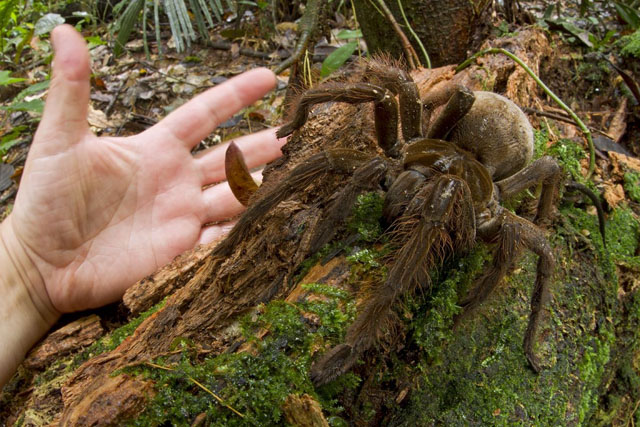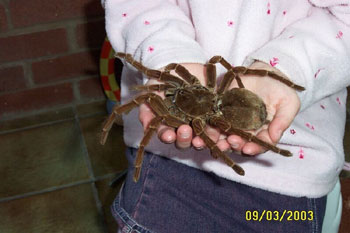The Goliath Bird-eating Spider – The Biggest Spider On Earth
The Goliath bird-eating spider is one of the biggest spiders on earth; I know in the title I put “biggest” for “shock” value, but let me explain. The Goliath birdeater, or Theraphosa blondi for those of you with a Latin fetish, is the 2nd largest as far as leg span is concerned. It clocks in at a mighty 28cm (11 in) and comes slightly after the giant huntsman spider. When it comes to the weight of the beast, it sits in 1st place (probably), weighing in at 170g (6oz).
Despite it’s name, it rarely eats birds, it just so happened that the first one to be spotted and engraved by a Western naturalist in the 18th century pictured it snacking on a humming bird. The name stuck. It’s more likely to eat insects, rodents and frogs with the occasional lizard and snake thrown in to make sure it’s getting it’s 5 a day. It’s fangs are the size of a cheetah’s claw…. OMG.
These fearsome looking miniature leviathans are found marauding in South America, in marsh and swamp land. Like most tarantulas they are burrowers and dig out deep pits to hide in, or second a burrowing mammals left over home in the dirt.
Lifespan
Females reach maturity in around 2-3 years and can live to be 15-25 years old. They spend most of their life in their silk lined burrow. The men, however, have much shorter life spans and tend to die soon after mating. Less fortunate males will be eaten by the female, and reportedly 50% of males get either eaten or maimed during or after the dirty deed.
Goliaths are nocturnal creatures and never stray too far from their burrows, spending most of their life just a few feet from their holes. They don’t use webs or traps for hunting, they are just very patient and excellent at creeping up. As most insects and arachnids do, they then regurgitate digestive juices and break it down before swallowing the tasty snack.
Are They Dangerous?
If you do come face to face with a Goliath bird-eating spider don’t worry too much, their bite isn’t much worse than a wasp sting for someone of human size (if there’s any mice reading this you definitely should be worried though). They only really bite out of self defense, so sometimes the bite will only be a “dry bite” i.e. no venom is squirted into your veins. Their other method of defense is to rub their abdomen to release hairs which are urticating and can cause pretty bad irritation if they get into your eyes or any mucous membranes. These urticating hairs are similar to the sting of nettles. The hairs are barbed, and once inside are not eager to be removed. So, once again, if you do end up eye to eye with a Goliath birdeater, make sure your eyes are a good few metres from his.
CLICK HERE FOR AN ARTICLE ABOUT SPIDER SILK
Video
Apparently they aren’t very good pets because, as spiders go, they’re pretty crotchety. Here’s a video of some fella feeding a live mouse to his pet Goliath birdeater. If you’re impatient skip to 1:00 when the action hots up:
If you’re not completely grossed out there’s more pics on the next page and a video of them breeding…






















